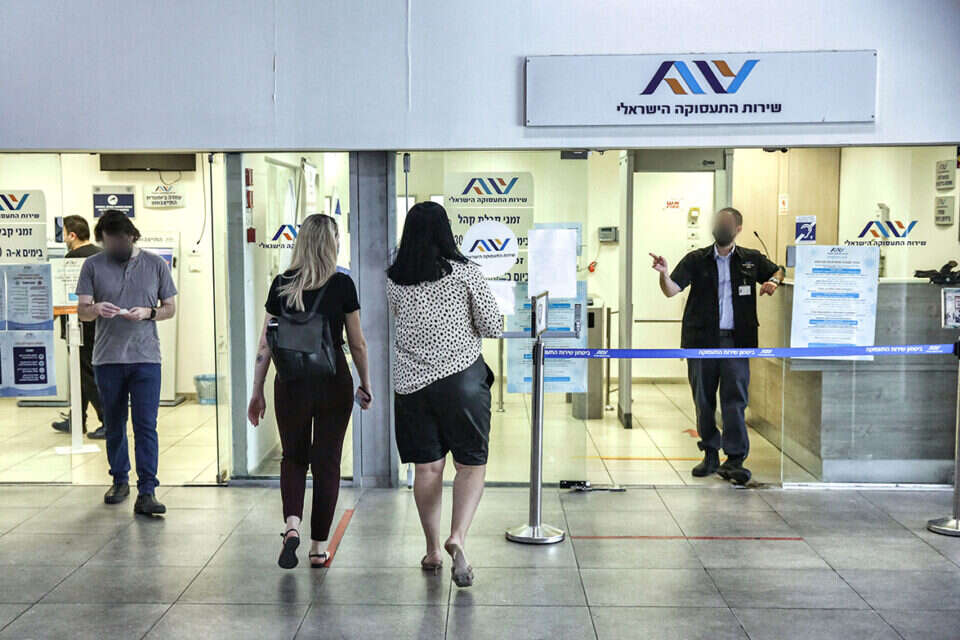During the last month of July, there was a 35.1% decrease in the number of job seekers, from 449,000 at the end of June to 291,000 at the end of July.
At the beginning of July, their number was 303,494.
This is according to data from the Employment Service.
The number of unemployment claimants recorded the highest decline since the outbreak of the corona crisis during July.
The driving force behind the decline is the cessation of entitlement to unemployment benefits for job seekers aged 44 and under, which took effect earlier this month.
However, like the US, where the federal unemployment benefit cut did not lead to a corresponding increase in employment rates, in Israel too the rate of return to work is relatively slow compared to the decline in the number of job seekers and the number of job vacancies remains high.
The Employment Service notes that it is too early to explain the relatively low rate of return to work and believes that it is necessary to wait for the employment data to be recorded at the end of the holiday period.
The service speculates that the relatively low rate of return to work may depend on the summer season, which is characterized by seasonal layoffs and the holiday period that begins this year in early September.
The expectation is for an increase in the rate of return to work.
However, along with the general decline in the number of job seekers, there has been a significant increase in the number of job seekers who are not entitled to unemployment benefits and yet apply to the employment service for assistance in returning to work or job offers, job training and career counseling.
While in June their number was 49.7 thousand, in July their number was 76.1 thousand.
This is an increase of 53.1% and the employment service estimates that this group is expected to grow in the coming months as many will find it difficult to return to the labor force.
On the other hand, there has also been an increase in the rate of jobseekers claiming employment, which is explained by the Employment Service in that unlike unemployment claimants, whose annuity is usually fixed at a set time and now the 44-year-olds eligibility period ends, claimants usually find it difficult to return to work. Allowance for an extended period.
The Employment Service also believes that in the coming months an increase in the rate of income support claimants is expected, and possibly also in their number.
This is in view of the estimated increase in the number of people returning to work, certainly with the end of the eligibility period for those aged 45 and over that will apply in the coming months, as well as quite a few job seekers, often with low work skills, who will have difficulty returning to work and need social benefits.
Number of sickness plaintiffs: The lowest since the outbreak of the corona crisis
One of the characteristics of the employment crisis that has befallen Israel since the spread of the corona epidemic was the use of the spending mechanism for the IDF, when the rationale was to maintain contact between job seekers and their workplaces while bearing the state wage burden. The chances of returning to work for jobseekers who are staying in the Knesset and remaining with an employer at the end were higher than those who were without an employer at the end, whether they were fired or resigned. In fact, since leaving the third quarantine, there has been a consistent decrease in the proportion of jobseekers staying in Khalat, compared with an increase in the rate of jobseekers not staying in Khalat.
This trend intensified during July, when the number of plaintiffs in the IDF decreased by 92.2 thousand and their rate decreased from 32.2% in June to only 19.2% in July, the lowest since the outbreak of the crisis. From 45.7% in June to 39.5% in July, while at the same time the rate of income support claimants rose from 12% in June to 19% in July. As mentioned, the increase in the rate of income support claimants is due to the fact that income support recipients have more difficulty returning to work than unemployment benefit claimants and their number and rate is expected to rise in the coming months, both due to their difficulty returning to work and many of those who lose unemployment benefits. And may need social benefits as an income guarantee.
At the same time, there was a significant increase in the rate of job seekers who do not claim any pension from 10% in June to 22% in July.
This increase provides another indication that many of those who have lost their entitlement to unemployment benefits are in no hurry to return to work and may be in a kind of waiting period that may end at the end of the holiday period.
Among young people: Slow rate of return to work
As for ages, it appears that in recent months most industries in the economy have opened up to activity in full, especially the industries in which young people are over-represented. Due to this, and due to the end of the period of entitlement to unemployment benefits for those aged 44 and under at the end of June, the age distribution of the number of jobseekers registered with the employment service changed significantly during the month of July. Although the number of young job seekers has decreased significantly, the demand for workers in industries where there is over-representation of young people is increasing and in fact has been at its peak since 2009. For example, in the second quarter of 2021 the number of waiters and bartenders was about 15,000. These data indicate a relatively slow rate of return to work and, according to the Employment Service, strengthen the service's assessment that we are in a waiting period, which will probably end at the end of the holiday period, after which an increase in the rate of return to work is expected.
Although the number of young jobseekers has decreased significantly, the demand for workers in industries where there is over-representation of young people is increasing and in fact has been at its peak since 2009. For example, in the second quarter of 2021 the number of vacancies in waiters and bartenders was about 15,000. These data indicate a relatively slow rate of return to work and, according to the Employment Service, strengthen the service's assessment that we are in a waiting period, which will probably end at the end of the holiday period, after which an increase in the rate of return to work is expected.
As for the distribution in terms of socio-economic criteria, it appears that the stronger the group, the more significant the rate of change recorded in the number of job seekers in its vicinity. Examining the gender distribution of job seekers in July, it appears that similar to the situation prior to and during the outbreak of the crisis, the rate of job demands is higher than the rate of job seekers. However, as it has been throughout the crisis, at and during closures, women are more likely to register as job seekers compared to men, but when leaving closures they return to work at a higher rate than men.















